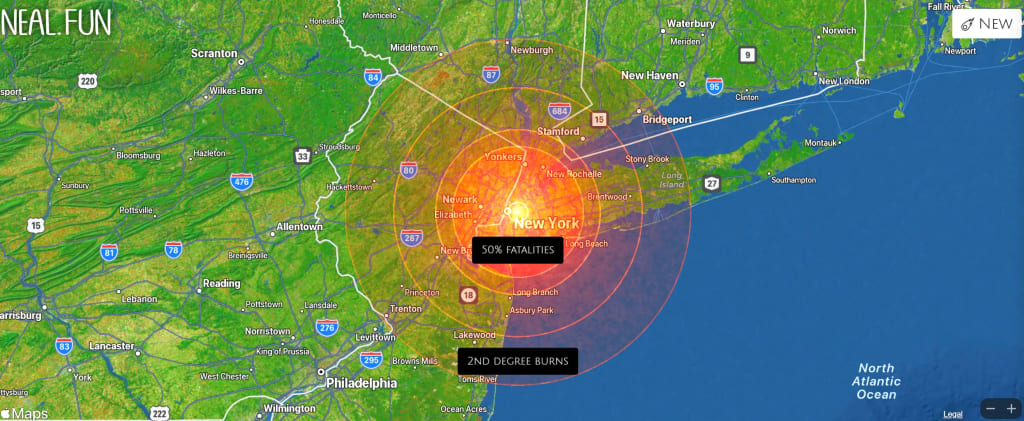A "potentially hazardous" asteroid bigger than a skyscraper reaches Earth next week
It's expected to miss us

In brief: An asteroid the size of the Empire State Building that has been classified as potentially hazardous is blasting toward Earth and will arrive next week. But we don't have to worry, apparently, as the object will pass us, though it will be comparatively close to our planet.
Asteroid 1994 XD, which was discovered by the Spacewatch group at Kitt Peak Observatory in Arizona in 1994, will come as close as 1.8 million miles to Earth, or about eight times the average distance of the moon, just before 9pm EDT on June 12.
The asteroid is between 1,214 to 2,723 feet in diameter and is traveling at 77,301 kilometers per hour (48,032 mph). According to the Asteroid Launcher simulation website, assuming the asteroid is 1,500 feet in diameter and hit Earth at a 45-degree angle, Asteroid 1994 XD landing in New York City would leave a crater 2.1-miles wide, vaporizing around 60,000 people. A 6.8-mile fireball would kill over 6 million, and 5.6 million would die from a 264-decibel shockwave. There would also be a 6.0 magnitude earthquake.
But don't worry about it
That level of potential destruction stemming from the asteroid's size has earned it the title of a Potentially Hazardous Object. But Asteroid 1994 XD has been even closer to Earth in the past: just 1.5 million miles away on May 31, 1904. It last passed our home on November 27, 2012, and after next week will make another close pass of the Earth in 2041.
According to NASA's Center for Near Earth Object Studies (NEOS), more than a dozen objects with close approaches to Earth are being tracked.
While Asteroid 1994 XD is expected to pose no risk to our planet, there will likely be a lot more concern on Valentine's Day 2046. That's when asteroid 2023 DW has a 1 in 560 chance of hitting us, or 1 in 625 chance, according to European Space Agency. Thankfully, that one's a lot smaller than 1994 XD – about the size of an Olympic swimming pool.
Last year, NASA carried out the Double Asteroid Redirection Test (DART) mission, attempting to deflect a celestial object by launching and crashing a spacecraft into it. The mission was a huge success, altering the small asteroid Dimorphos' orbit more than expected.
What just happened? NASA last summer announced it was assembling an independent team to study UAP, or unidentified aerial phenomena – previously referred to as UFOs, but now called "unidentified anomalous phenomena." The space agency held the first public meeting involving the commissioned team this week before their report arrives this summer, and it was a dog and pony show from the get go.
Nicola Fox, associate administrator for science at NASA, said the study was commissioned to create a road map on how to use the tools of science to evaluate and categorize the nature of UAPs going forward. This road map, Fox added, will help the government obtain usable data to explain the nature of future UAPs.
"The nature of science is to better understand the unknown and to do that, our scientists need data," Fox said.
Not just any data, mind you, but high quality data. Daniel Evans, assistant deputy associate administrator for science research at NASA, said the team's objective is not to go back and look at grainy footage of UAPs. Presumably, one would want to study the highest quality data available captured using the most sophisticated equipment around.
Fox said UAP sightings themselves are not classified, but the sensor platforms used to capture the data are. Imagine if a fighter jet took a photo of the Statue of Liberty. That picture would be classified – not because of the subject but because of the camera system used to capture it. In short, the government wants its data collection capabilities to remain a mystery to other countries.
As such, NASA's team is only analyzing unclassified data from civilian government entities, commercial data, and "data from other sources." If they are intentionally excluding the best evidence, why even bother at all?
"Lack of high quality data makes it impossible to draw scientific conclusions on the nature of UAP." – Nicola Fox, NASA
All of this came within the first 15 minutes of the four-hour meeting.
David Spergel, chair of the NASA team studying UAP, said that after the preliminary data collection stage, they learned that current data collection efforts are unsystematic and fragmented across various agencies. What's more, data is often collected using instruments that are uncalibrated for scientific data collection.
Spergel also touched on the stigma associated with the phenomena, and that it likely leads to many incidents going unreported. NASA wants to help eliminate the stigma, he said, which could lead to the collection of more high quality data.
Unfortunately, those hoping for a smoking gun will have to wait a bit longer. "The origin of UAPs remains unclear," Spergel said.
Late last year, President Biden signed into law the 2023 National Defense Authorization Act (NDAA) which included an amendment providing protection to whistleblowers who supply information about "any activity or program by a department or agency of the Federal Government or a contractor of such a department or agency relating to unidentified anomalous phenomena, including with respect to material retrieval, material analysis, reverse engineering, research and development, detection and tracking, developmental or operational testing, and security protections and enforcement."
Given the incomprehensible vastness of space, it seems highly improbable that we are alone in the universe. There's no shortage of theories to subscribe to, including the belief that extraterrestrials have been visiting Earth for a long time and that the government knows way more about the subject than we've been led to believe.
About the Creator
Enjoyed the story? Support the Creator.
Subscribe for free to receive all their stories in your feed. You could also pledge your support or give them a one-off tip, letting them know you appreciate their work.





Comments
There are no comments for this story
Be the first to respond and start the conversation.